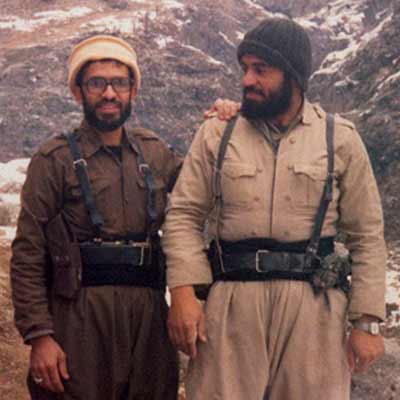Battles
Operation Zafar 5 (Islamic Revolutionary Guard Corps)
Azam Sadat Hussaini
277 دورہ
In 1988, the Ramazan Headquarters, in cooperation with the Peshmerga forces of the Kurdistan Democratic Party of Iraq, the independent Shahadat Battalion, and units from the 58th Malek Ashtar Brigade, carried out Operation Zafar 5 in northwest Iran.
The Iranian forces, which consisted of the Malek Ashtar Brigade and the Shahadat Battalion, had been stationed near the Turkish border days before the operation. Finally, backed by the Kurdistan Democratic Party of Iraq, they launched a multi-pronged attack from three directions—Kirkuk, Dehouk, and Diyala provinces—on Iraqi military positions. Throughout 1987-1988, the Ramazan Headquarters of the Islamic Revolutionary Guard Corps (IRGC) carried out a series of successive infiltration operations that raised concerns among the Iraqi military commanders, thereby making them shift their focus to the mountainous regions of Iraqi Kurdistan. In the meantime, the role of Iraqi Kurdish opposition forces proved highly effective. Their cooperation with Iranian forces led to significant achievements and success on the northern front. In line with this broader strategy, Operation Zafar 5 was a limited, irregular attack on January 12, 1988. The operation lasted two days and was launched with the code-name “Ya Zahra (s)” to advance up to 200 kilometers into Iraqi territory.[1]
On the front, the Iranian units targeted bases around Dirluk in Dehouk Province. They inflicted heavy losses on Iraqi forces, disrupted key supply routes—including the strategic Emadiya–Dirluk Road—and prevented any Iraqi counteractions. The Iranian troops successfully entered Dirluk and thus the government buildings, military centers, the Baath Party headquarters, intelligence facilities, and the local administration office were set on fire. In this operation, the Iraqi forces suffered over 500 casualties (killed and wounded), and also 260 were taken prisoner. In addition, 36 outposts overlooking Dirluk were destroyed, and Iranian forces seized 7 military vehicles, one armored personnel carrier, and hundreds of light and semi-heavy weapons.[2]
On the second front, Iranian units attacked the Mandaliyeh Base, located 7 kilometers from Kirkuk and 150 kilometers deep inside Iraqi territory. The 75th Zafar Brigade commandos, in collaboration with the Kurdistan Democratic Party of Iraq, launched an assault on Iraq’s 16th Battalion of the 22nd Brigade, resulting in over 200 Iraqi casualties and 80 captives. Several tanks, armored vehicles, 20 trucks, and other Iraqi military equipment were also destroyed.[3]
Meanwhile, the units under the command of Ramazan Headquarters attacked the command, logistics, engineering, communication, and other centers of the Iraqi 21st Division in the “Meidan” area of Diyala Province and managed to destroy about 40% of these facilities. 7 bulldozers, 46 military vehicles, and an ammunition depot were set on fire, and over 1500 Iraqi soldiers were killed. The IRGC 75th Zafar Brigade commandos and the Sulaymaniyah units of the Kurdistan Democratic Party ambushed Iraqi forces on the Sulaymaniyah–Kirkuk Road, killing 30 more and capturing 80.[4]
The second phase of the operation began in the early hours of January 13th when the Iranian forces started moving forward along the Dirluk– Sheladize and Dirluk–Emadiya routes. Ramazan-affiliated troops expanded their offensive towards Emadiya, 30 kilometers from Dirluk, inflicting further losses on Iraqi forces and destroying a key bridge. In a confrontation with the enemy commandos, 700 Iraqis were either killed or wounded, and several others were captured. Furthermore, all Iraqi defensive posts and outposts in that area were destroyed. Iranian forces managed to take control of the heavily fortified “Kuwaei” fortress, 10 kilometers from Emadiya, killing, wounding, or capturing all personnel inside. The city of Sheladize, located 20 kilometers southeast of Dirluk, also came under Iranian attack during which over 40 Iraqi military outposts and bases were wiped out, and Iranian troops took positions on the high ground overlooking Sheladize. While fierce ground combat was ongoing, the Iraqi Air Force launched sporadic air raids. However, one Sukhoi-22 was shot down by Iranian anti-aircraft artillery, and its pilot was captured.[5]
The outcomes of Operation Zafar 5 for Iran included the destruction of 4 battalions in Dirluk, 1 Sukhoi aircraft, 46 military vehicles (light and heavy), and 7 bulldozers. More than 1500 Iraqi soldiers were also killed or wounded, and 500 were taken prisoner.[6]
[1] Samiei, Ali, Karnama-ye Tosifi-ye Amaliyat-e Razmandegan-e Eslam dar Tool-e Hasht Sal-e Defa Muqaddas (Descriptive Record of the Operations of the Islamic Combatants during the Eight-Year Sacred Defense), Tehran: Namayandegi-ye Vali-e Faqih dar Niroo-ye Zamini, Moavenat-e Tablighat va Entesharat, Edari-e Ravabet Umoumi va Entesharat Sepah-e Pasdaran-e Enqelab-e Eslami, 1997, p. 396; Habibi, Abolqasem, Karnama-ye Amaliyat-e Sepahiyan-e Eslam dar Hasht Sal-e Defa Muqaddas (Operational Record of the Muslim Combatants during the Eight-Year Sacred Defense), Tehran: Edari-e Ravabet Umoumi va Entesharat Sepah-e Pasdaran-e Enqelab-e Eslami, 5th edition, 2004, p. 194.
[2] Samiei, Ali, Karnama-ye Tosifi-ye Amaliyat-e Razmandegan-e Eslam dar Tool-e Hasht Sal-e Defa Muqaddas (Operational Record of the Soldiers of Islam during the Eight-Year Sacred Defense), Pp. 366–367.
[3] Ibid., p. 367.
[4] Izadfam, Mahmoud, Roozshomar-e Jang-e Iran va Araq, Ketab-e Panjaah-o-Dovvom: Takapooye Jahani baraye Tavaqof-e Jang (Chronology of the Iran–Iraq War, Vol. 52: Global Efforts to Stop the War), Tehran: Markaz-e Motaleat va Tahqiqat-e Jang-e Sepah-e Pasdaran-e Enghlab-e Eslami, 2003, p. 600; Habibi, Abolqasem, Karnama-ye Amaliyat-e Sepahiyan-e Eslam dar Hasht Sal-e Defa-e Muqaddas (Operational Record of the Muslim Combatants during the Eight-Year Sacred Defense), p. 195.
[5] Samiei, Ali, Karnama-ye Tosifi-ye Amaliyat-e Razmandegan-e Eslam dar Tool-e Hasht Sal-e Defa-e Muqaddas (Operational Record of the Muslim Combatants during the Eight-Year Sacred Defense), Pp. 367–368.
[6] Habibi, Abolqasem, Karnama-ye Amaliyat-e Sepahiyan-e Eslam dar Hasht Sal-e Defa-e Muqaddas (Operational Record of the Muslim Combatants during the Eight-Year Sacred Defense), p. 120.



